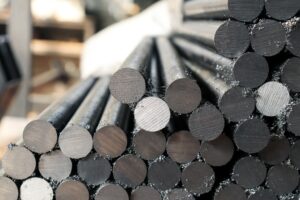Intro
Understanding the differences between different metal options is the first step in picking the right metal for your upcoming project. A part made out of stainless steel supposedly prevents stains and rust, but is this true?
This guide will explain how stainless steel can offer this feature. We’ll explain what this type of steel is, how rust happens in the first place, and the scientific reason why stainless steel is truly “stainless”.
What Is Stainless Steel
Stainless steel is a type of metal that you might see in applications from kitchen appliances to cutlery and surgical implants. In engineering, it’s a very common material choice.
What a lot of people don’t realize is that stainless steel isn’t a specific piece of metal, it’s a name that applies to a wide range of alloys. In general, stainless steel is any steel alloy that has more than 11% composition of Chromium.
In fact, most of the “stainless” nature of stainless steel has to do with this addition of Chromium to an iron and carbon combination.
So, why is it called “stainless steel”? Well, one of the big selling points of this metal is that it’s a lot harder to rust and stain than other metals like carbon steel.

Understanding How Rust Works
In almost any application, rusting metal is a bad thing. You might see it on an old swing set, inexpensive forks that have been used for a while, or older cars.
Rust is a form of oxidation that only occurs in metal. It happens when oxygen reacts to iron and creates iron oxide. Adding salt or water to the process can speed things up, but this process will also happen naturally.
The rust that forms is a separate material that is much weaker and more brittle than the iron that used to be present. This is why you can pick off flakes of rust and expose clean metal underneath. The problem is that rust eats away at metal and creates holes and weak spots.
Problems with Rust on Parts
Rusted metal is a massive issue in manufacturing and engineering applications. Having rust on your parts can lead to a host of different issues:
It Adds Friction
If you have two parts that need to slide on one another, rust will ruin that operation. Iron oxide has a much higher friction coefficient than standard steel or iron, especially if the steel was polished and smoothed out in the first place.
Reduces the Part’s Magnetism
Another problem with iron oxide is that it’s no longer magnetic. When parts rust, they lose their magnetism.
Can Lead to Stress Failures
With pitting, cracks, and holes created during the rusting process, you can be left with a part that has a much lower strength. As a result, your stress simulations and calculations won’t be applicable to your part anymore.
It’s the same scenario as drilling out portions of your part and assuming it can still hold the same load.
This is why metal staircases have to be routinely checked for rust as part of OSHA requirements — once rust is present, the staircase can’t handle the same force which means it can fail if someone goes up the stairs.
Reduces Electrical Conduction
In applications where your metal part has to be a conductor, rust will ruin everything. Iron is generally really good at passing electrical charges, but iron oxide is terrible at it (since it’s an insulator).
How Is Stainless Steel “Stainless”?
Now, let’s go back to what makes stainless steel “stainless”. As we described, rust is the oxidation process that happens with loose iron atoms. But, stainless steel has Chromium which goes through its own oxidation process with air, making Cr2O3. The difference is that Cr2O3 is a good form of oxidation — it adds a passive layer on the outside of your part that is resistant to staining or rusting.
In other words, Chromium sacrifices itself to oxidize with air and create a good version of rust, a version that helps your part instead of breaking it down.
However, these bonds can break down over time and they can’t protect all of your part’s iron atoms. You can still find old pieces of stainless steel that have rust on them. In acidic, salty, or wet environments you’ll still get iron oxide that forms on the stainless steel. In addition, scratching the steel can disturb the Cr2O3 bonds and free up some iron atoms that can lead to rust.
When Rusting Is a Problem, Choose Stainless Steel
When you’re designing a part that needs to avoid rusting, it’s a good rule of thumb to start with stainless steel. You might also consider using aluminum if you don’t need a part that’s as strong as steel.
Conclusion
As you just saw, stainless steel is a great option for stain-free and rust-free parts. The added Chromium creates a safe barrier that protects your part from rust. If you need help picking the right metal for your next project, you can trust Rapid Axis. We are a full-service machine shop that offers CNC machining, high-quality sheet metal fabrication, and die casting processes, plus a number of finishing services. Get a free quote today.

